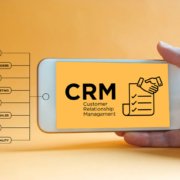Senior Living Marketing: All About CTAs
When it comes to effective senior living marketing, the little things can make a BIG difference. And that is most certainly true when it comes to calls-to-action or CTAs. Let’s take a deeper look . . .
What’s a call-to-action (CTA)?
A call-to-action is exactly how it sounds—words that motivate someone to do something specific, like register for a webinar, listen to a podcast, or download a piece of content.
A CTA can be subtle, like a hyperlinked line of text within a longer piece of content. The link leads to the offer; this is known as an anchor text CTA. Using anchor text CTAs in your blog posts, for example, can increase conversion rates by 121%.
CTAs can also be more obvious, like a bright red button that says: REGISTER FOR OUR WEBINAR. (One company found that using red CTA buttons increased its conversion rates by 21%.)
Bottom line: Never underestimate a CTA’s importance. Implementing a thoughtful CTA strategy throughout your website can help convert anonymous website traffic into bonafide leads—and leads into move-ins.
What are some examples of CTAs in senior living marketing?
Popular CTAs in the senior living industry include the following:
- Book a Tour
- Plan a Visit
- Get in Touch
- Request Pricing
- Download Floorplans
- Chat with a Live Agent
- Get Our Free Guide
- Sign Up for Our Newsletter
But honestly, the sky’s the limit when it comes to CTAs. If there’s an action you want a person to take, you can create a specific CTA to urge them to do exactly that.
By the way, using first-person phrasing in CTAs has been shown to increase conversions. Using some of the examples from above, we’d recommend rewriting and testing some of these:
- Yes! I want to book a tour.
- Yes! I want to plan a visit.
- Please send me pricing!
- Yes, I’d like to view floorplans.
Are there any best practices when it comes to creating CTAs for senior living marketing?
Always remember your audience and put yourself in their shoes. You’re either talking to older adults who are investigating senior living options for any number of reasons (both happy and sad ones). Or you’re talking to adult children (or other family members) seeking info on behalf of their older loved ones.
For senior living marketing, the best CTAs will be . . .
- Clear, not coy. Save playful copy for the content itself rather than the CTA. That said, “clear” doesn’t mean “cold.” The tone should reflect the overall tone of your senior living website and other marketing materials. You’ll be using only a handful of words, usually no more than five. Make every single one count.
- Easy to read. Even if you use an anchor text CTA, make sure the hyperlink is obvious. Remember, you’re often dealing with aging eyes, so you want a clear contrast between the font color and hyperlink color. With image CTAs, like buttons, the words within any graphics should also be easy to read.
- Accurate. Meaning that when someone clicks, they are led to a page that will make sense to them. For example, if someone clicks on “Book a Tour,” but they’re brought to your site’s main Contact page, they might feel a disconnect. Instead, the “Book a Tour” CTA should lead to a dedicated landing page for booking tours. On it, you’d have a short form to schedule a tour AND information about what to expect on a tour, like how long tours last, where people should go for the tour, current policies about masks, and so forth.
- Used thoughtfully throughout the site (and other marketing materials). Be intentional with your CTA placement. Look at high-trafficked pages on your site and ask yourself: “Where’s the most logical place for people to go next?” Create a CTA that then leads people to that next logical place. CTAs aren’t just for your website, either. Think about emails. Think about digital ads. Think about social media posts.
How do you determine if your CTAs are working hard enough in your senior living marketing? (And how can you make them work harder?)
The worst thing you can do with a CTA is set it and forget it. Like any other marketing tactic or campaign, you need to review results and adjust accordingly. Follow these tips.
- Know what you’re measuring.
Make sure you understand the difference between click-through rate (of the call-to-action button itself) and conversion rate on the page you send people to.
For example, let’s say you have a CTA button that says, “Get our guide on senior living financing,” and it has a high click-through rate (CTR). But once people land on the page with the form to download the guide, they bounce away quickly, resulting in a low landing page conversion rate.
It’s easy to think the problem is the landing page—and that might very well be true. But you’ll want to take an objective look at the CTA as well. And vice versa: If a CTA button doesn’t have a high click-through-rate, but for those who DO click, they convert on the landing page . . . you need to take a hard look at both and figure out where the friction or disconnect is.
- Conduct A/B testing. (Also known as split tests.)
The key with A/B testing is to test only one change at a time. So, for example, maybe one CTA button is red and the other is blue. If more people click the red button, then you can (likely) deem red the winner. From there, you can conduct another test. Perhaps you change the verbiage: “Download our guide” to “Yes! I want the guide.” Read HubSpot’s tutorial on how to do A/B testing.
- Experiment with smart or dynamic CTAs.
Smart or dynamic CTAs are personalized to the person visiting the site. The CTA might use a person’s first name. (HubSpot reports that personalized CTAs perform 202% better than basic CTAs.) Or the smart CTA workflow might deliver certain calls-to-action based on info a person provided elsewhere (like a form) or the path they’re taking through the site.
Still having issues with CTAs in your senior living marketing? Let us help.
If you’re not getting the results you want, seek advice from an agency that understands the ins and outs of CTAs. At Senior Living SMART, we know digital marketing and senior living. Get in touch and let’s chat about CTAs. (And that right there is an example of one!)












